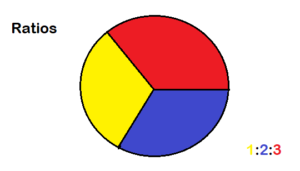In this article, you will learn about the Properties of Ratios. Ratios are one of the most important concepts in mathematics because of that we can understand how important they are in our day-to-day life. These play a major role in several things. Ratios are perhaps one of the most commonly used concepts that you can definitely know about it. Ratios are simple in the mathematical term used for comparing two or more quantities that are measured in the same units.
On this page, we will discuss the definition of Ratios, Properties of Ratios, Example questions belonging to the concept, and so on. Ratios are mainly explained using fractions. If a fraction expresses in the form of a:b then it is called a ratio and when two ratios are equal it is said to be in proportion.
Also, Read:
Ratio – Definition
Ratios are the comparison of two quantities or more quantities that we express as a fraction. The concept of equivalent fractions will allow the ratios of different physical quantities to be the same sometimes. In some cases, the comparison of two quantities are using the division method is difficult. So, at that time, we use a ratio. The ratio explains to us how many times one quantity is equal to another quantity. So, the two numbers in a ratio can be expressed only when they have the same unit. The sign of ratio is ‘:’

The real examples of a ratio are the rate of speed means distance/time, price of material means rupees/meter, and others. Hence, a ratio is a general independent term of a unit and we used for across multiple platforms.
Points to remember regarding Ratios
- The Ratio will exist between quantities of a similar kind.
- During Comparison the units of two things or quantities must be similar.
- There should be significant order of terms
- Comparison of two ratios is performed if the ratios are equivalent to similar to fractions.
Ratio Formula
Consider that, suppose we have two quantities and we have to find the ratio of these two quantities, then the formula for that ratio is defined as
a: b ⇒ a/b
Where a, b be are two quantities. In this formula, a is called the first term or antecedent, and b is called a second term or consequent.
Students of 6th Grade Math can find plenty of concepts relating to mathematics all under one place here and get acquainted with concepts on a deeper level.
Properties of Ratios
Property 1: We will express a Ratio only between two quantities of the same kind.
Property 2: In ratio, quantities to be compared by the division must be in the same units.
Property 3: In a ratio p: q, the first term that is P is called antecedent and the second term Q is called the consequent.
Property 4: The order of the terms in ratios is very important that is the positions of antecedent and consequent are not interchangeable.
Property 5: We call two ratios equivalent if their corresponding fractions are equivalent.
Property 6: If more than one like quantities are expressed in a ratio format, the resultant is termed as a Continued Ratios or a Compassion between the quantities. It can simply be represented as p: q: r: s.
Property 7: Both the terms of a ratio can be multiplied or divided by the same (non-zero) number. Generally, the ratio is expressed in the lowest term or simplest form.
Property 8: If a quantity increases or decreases in the ratio p: q, then the new quantity is (b x original quantity) / a. The fraction by which the original quantity is multiplied to get a new quantity will be called the factor multiplying ratio.
Property 9 (Invertendo Property): One ratio is the inverse of another if their product is 1. Thus a:b is the inverse of b: a and vice-versa.
Property 10: A ratio a: b is said to be of greater inequality if a > b and of lesser inequality if a < b.
Property 11 (Alternendo Property): The ratio compounded of the two ratios a: b and c : d is ac: bd, that is, if the second and third terms interchange their places, then also the four terms are in proportion.
Property 12: A ratio compounded of itself is called its duplicate ratio. So a2: b2 is the duplicate ratio of a: b. Similarly, the ratio of these a: b is a3: b3.
Property 13 (Componendo Property) : In ratio, we have four numbers a, b, c, d if a : b = c : d then (a + b) : b :: (c + d) : d.
Property 14 (Dividendo Property) : In dividend property, if a : b :: c : d then (a-b) : b :: (c – d): d.
Property 15 (Convertendo Property): If a:b :: c:d then (a-b) : b :: (c-d) : d , this is a convertendo property.
Property 16 (Componendo-Dividendo Property) : If a : b :: c : d then (a + b) : (a – b) :: (c + d) : (c – d).
Property 17 (Addendo Property) : In Addendo Property, If a : b = c : d = e : f, value of each ratio is (a + c + e) : (b + d + f).
Property 18 (Equivalent ratio property) : If a : b :: c : d then (a ± c) : (b ± d) : : a: b and (a ± c) : (b ± d) :: c : d, this is Equivalent Property.
Examples on Ratio Properties
Problem 1:
If the two numbers are in the ratio 3: 4. and the sum of two numbers is 49, find the numbers?
Solution:
Given that 3/4 is the ratio of any two numbers.
Let us consider the numbers to be 3x and 4x.
So, 3x+4x = 49
then, 7x = 49
x = 49/7
x = 7
Now, find the numbers we have 3x = 3*7 = 21
Next, 4x is 4*7 = 28
Therefore, the two sum numbers are 21, 28.
Problem 2:
If Rs 782 is to be divided in the ratio 6 : 8: 9, then what value would the first share correspond to?
Solution:
Given the value is Rs.782 is divided into a ratio of 6:8:9.
Now, consider a unit share to be equivalent to Rs x.
Then the first share would be equivalent to Rs 6x.
The second share would be 8x and the third share will be 9x.
By common sense, the sum of all shares should be equal to the total amount.
Thus the value is, =6x + 7x + 8x = 782.
So the value x is 23.
Therefore, clearly, the value of the first share is Rs 34*6 =Rs.204.
Problem 3:
The ratio of monthly income to the savings in a family is 6 : 3. If the savings be $12000, find the income and the expenses?
Solution:
Let us assume the Income be 6x and whereas savings be 3x.
The Given Savings amount is $12000.
So, the value is 3x = 12000
Then x = 12000/3 = 4000.
Now, the Income = 5x
Substitute x value in 5x. Then the value is,
5x = 5*4000 = $20,000
So, the Expenses is = Income – Savings = 6x – 3x = 3x
= 3*2000 = $6000.
Therefore, the Income and Expenses are $20,000 and $ 6000.
Problem 4:
If 2A = 3B = 5C, find the ratio of A : B : C?
Solution:
Let us consider that 2A = 3B = 5C = k
Now, Equating them we have A = k/2, B = k/3, C = k/5
Therefore, Ratio becomes = k/2:k/3:k/5
The LCM of 2, 3, 5 is 30
Now expressing them in terms of least common multiple we have
A:B:C = 15:10:6
Therefore, the ratio of A: B: C is 15:10:6.
